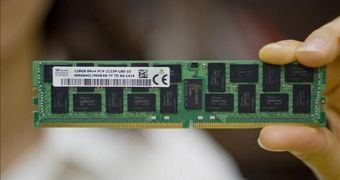You would think that 16 GB is a lot of memory for a single module, but SK Hynix must have felt that a change in perspective was warranted, so it launched one with a total capacity of 128 GB.
That's right, the company has introduced a DRAM module of 128 GB, put together from a bunch of DDR4 chips with a capacity of 8 Gb.
As one may have guessed, this is the first time a 128 GB DDR4 module is produced. For that matter, it is also the first time a 64 GB module is released.
ADATA has recently unveiled a range of DDR4 RDIMM modules with capacities of 4 GB, 8 GB and 16 GB, so one can easily see the difference.
Both companies' memories share similarities though, most notably the frequency of 2133 MHz and the operating voltage of 1.2V.
That's an ultra-low voltage setting below even the 1.35V, which is the minimum possible for DDR3 at this point in time.
Moreover, the SK Hynix 128 GB module, like the 64 GB one for that matter, can process 17 GB of data per second, thanks to the 64-bit I/O.
All in all, the new product, or pair of products, released by SK Hynix sounds like the perfect means to liven up your PC and reach greater performance heights than ever.
Which is a shame because the 20 nm chip-based memory is not made for desktop PCs and will not be usable in such computers even if you do somehow get your hands on a module.
Instead, it is server memory that will back the Intel Xeon E5-2600 v3 family of high-end central processing units.
If it's a DDR4 gaming PC you want, you'll, unfortunately, have to wait until next year (2015) or 2016, because desktop CPUs from Intel and APUs from Advanced Micro Devices won't support the technology before then.
And if we were to look at things objectively, DDR4 isn't truly necessary just yet in anything other than servers and supercomputers, except for workstations used to edit video and program games, maybe. If it's just running a game or program, DDR3 will still be just fine for a while.
Besides, it's the server industry where DDR4 will sell the best, since the annual average growth in DRAM will be of 37% until 2018. It's all because smartphones, tablets and connected wearables are growing in number and need more and more servers to handle the extra signal throughput.

 14 DAY TRIAL //
14 DAY TRIAL //